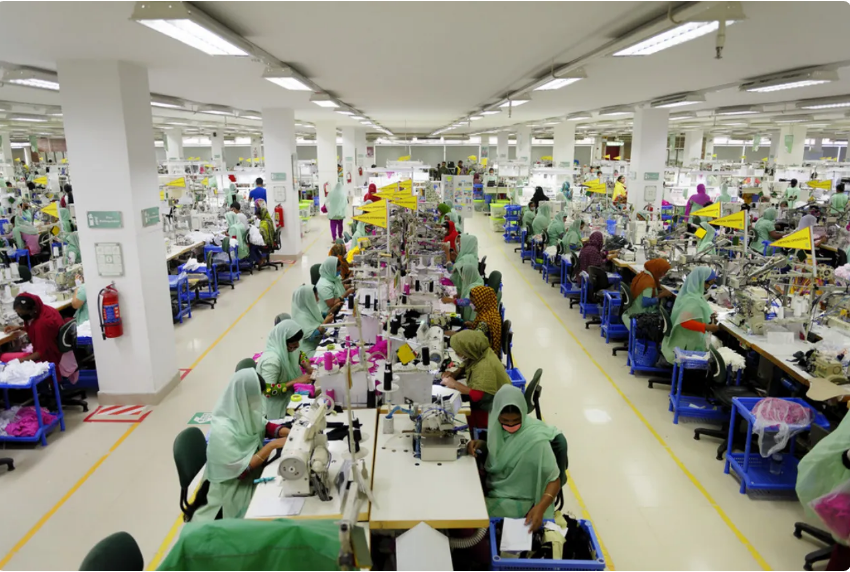
Bangladesh’s garment industry, the backbone of its economy and accounting for nearly 84% of its foreign exchange earnings, is facing a severe crisis. Over the past year, dozens of factories have closed, leaving tens of thousands unemployed. The crisis is fuelled by automation, labour unrest, and political instability, threatening the livelihoods of millions dependent on this sector. At least 52 garment factories in Chattogram have closed in the past six months due to a 25% drop in work orders, mainly caused by political instability, according to Industrial Police sources. This has left thousands of workers without jobs.
In addition, 44 more factories are struggling to pay wages and Eid bonuses. The Industrial Police has marked these factories as “at-risk,” but the Bangladesh Garment Manufacturers and Exporters Association (BGMEA) disagrees with this assessment. Out of 611 registered garment factories in Chattogram, BGMEA reports that only 350 are still running. Among them, 180 factories are working on foreign orders, while 170 operate as subcontractors.
However, Chattogram Industrial Police-3 reports different figures. Their data shows that 528 out of 580 factories linked to BGMEA, the Bangladesh Knitwear Manufacturers & Exporters Association (BKMEA), and the Bangladesh Textile Mills Association (BTMA) are still operational in the port city.
A report by Apparel Resources states that at least 76 garment factories have shut down in the past year, resulting in over 50,000 workers, mostly women, losing their jobs. Factory owners and industry leaders warn that closures could continue without urgent measures to stabilise the industry.
The downturn is mainly due to increased automation in garment factories. While technology has improved efficiency, it has displaced a significant portion of the workforce. Media reports automation has led to a 30.58% reduction in Bangladesh’s garment sector employment. Many low-skilled workers, particularly women and older employees, struggle to keep up with new technologies, making it hard to find alternative jobs.
Labour unrest has worsened the crisis, as workers protest for higher wages, better working conditions, and unpaid salaries. The Business & Human Rights Resource Centre reported 183 garment factories have shut down due to ongoing protests. Many factories have failed to pay wages on time, and workers have demanded fair treatment. The protests have disrupted production and delayed shipments, making global buyers nervous about sourcing from Bangladesh.
Garment workers protest
Workers of Jeans Manufacturing Company Ltd in Hemayetpur, Savar, blocked the Hemayetpur-Singair regional road this morning (March 25) after their factory was shut down indefinitely.
The protest began around 7:30 AM after the factory announced its closure under Section 13(1) of the Bangladesh Labour Act, which enforces a “no work, no pay” policy. Traffic was disrupted for nearly two hours before army personnel intervened, leading the workers to move near the factory by 9:30 AM. As of 11:00 AM, they were still demonstrating.
The workers said they were initially granted an eight-day Eid leave but had demanded 10 days, along with payment for 20 working days of March and overtime wages.
Tensions escalated on March 24 when workers staged a sit-in at the factory. Protesters claim that the management brought in outsiders, leading to a scuffle. Reports suggest an official was injured and hospitalized. Workers also alleged that some colleagues were arrested overnight, though police denied these claims.
Political instability threatens garment industry
Political instability has troubled the sector. The resignation of Prime Minister Sheikh Hasina and the formation of an interim government led by Chief Adviser Md Yunus have created uncertainty. Business leaders accused the new administration of not supporting the industry. Ananta Jalil, a prominent entrepreneur in Bangladesh’s garment sector, warned that the economy might collapse if the government continues to remove incentives for garment manufacturers. Speaking at a public forum, Jalil alleged that Yunus was shutting down the industry by eliminating support during important seasons like Ramadan and Eid.
With competition from garment-producing countries like Vietnam and Cambodia, Bangladesh is pressured to modernise its industry. A 2023 Shimmy Technologies survey, reported by Rest of World, found that 80% of Bangladesh’s top factories planned to invest in semi-automated machines within two years. While automation increases productivity, it also results in job losses, as machines replace workers. The report found some factories expected to reduce their workforce by 22% due to automation.
Workers face pressure, tracking, stress
Workers are facing increasing difficulties. Many are forced to work under extreme pressure, with automated tracking devices monitoring their productivity. According to Rest of World, devices like “Nidle” track the number of pieces a worker sews per hour. If they fail to meet their target, they risk being fired. Workers reported skipping meals and bathroom breaks to keep up with the machines, leading to health problems and stress.
Despite claims that automation improves wages and working conditions, union leaders argue that wage increases are due to worker protests. Kalpona Akter, president of the Bangladesh Center for Workers Solidarity, told Rest of World that while technology can be beneficial, it must be worker-friendly rather than exploitative.
The garment industry crisis has major implications for Bangladesh’s economy. With fewer jobs, many workers, especially women relying on these jobs, may fall into poverty. Factory closures mean reduced export revenues, which could weaken the country’s economic stability.






